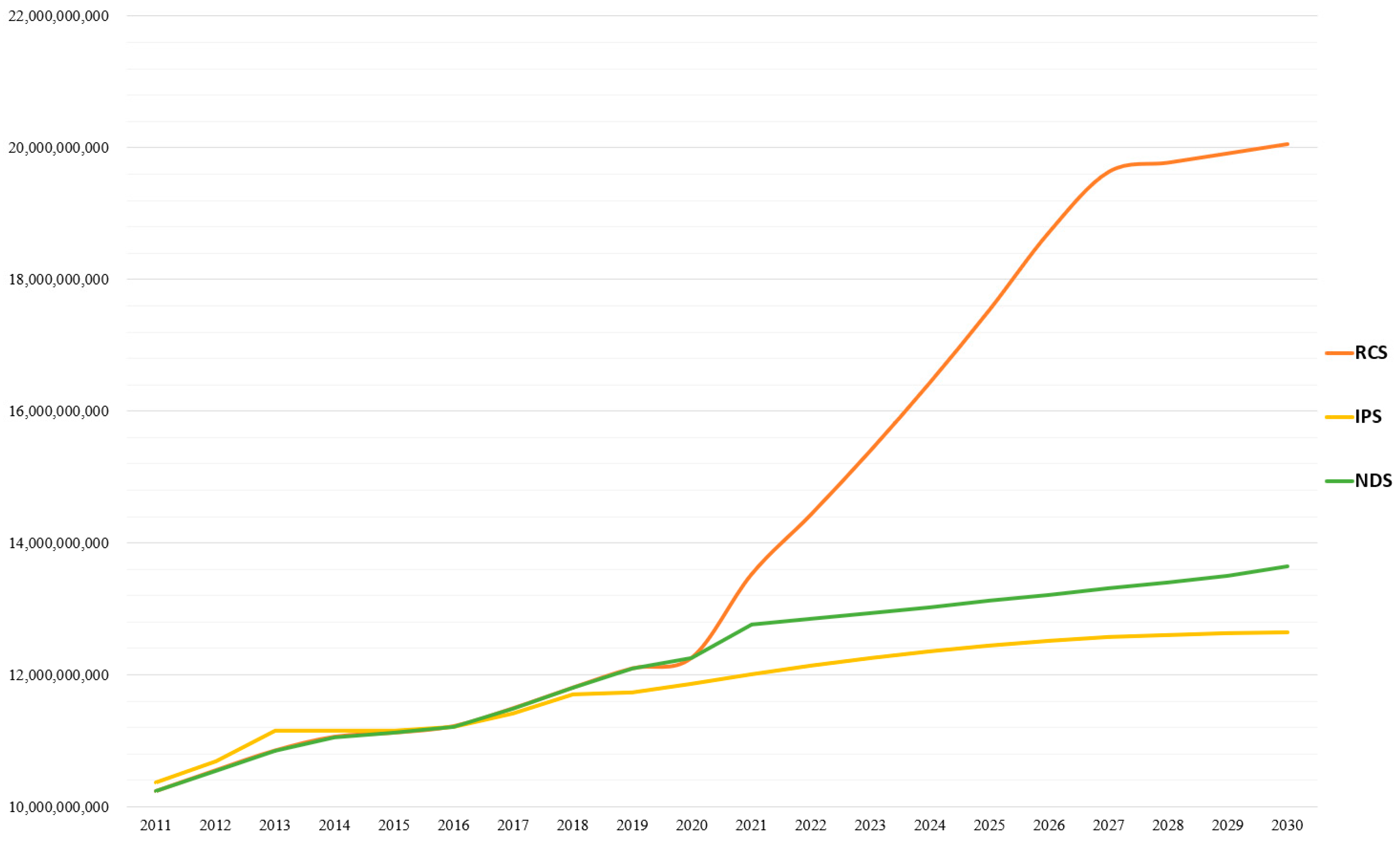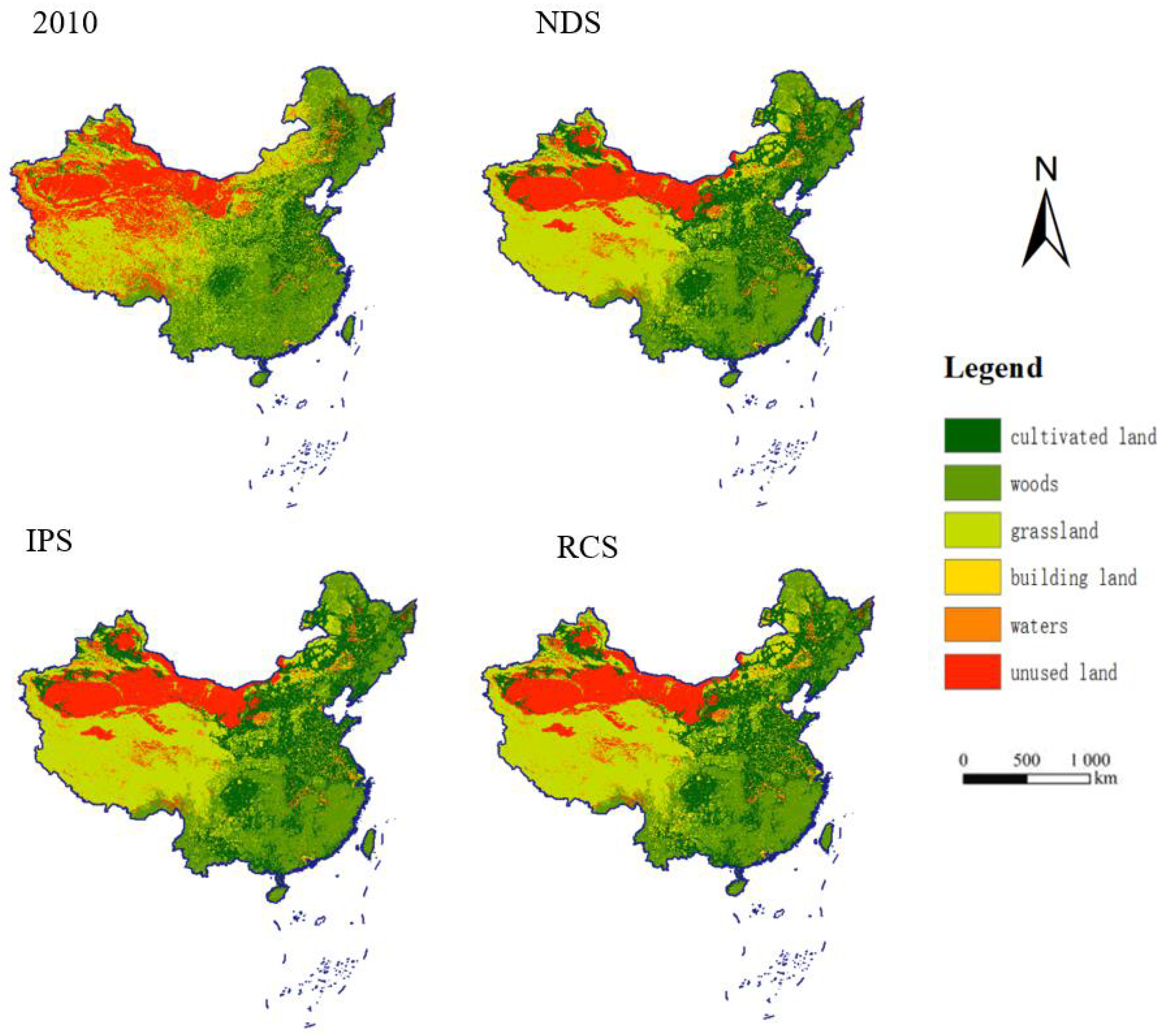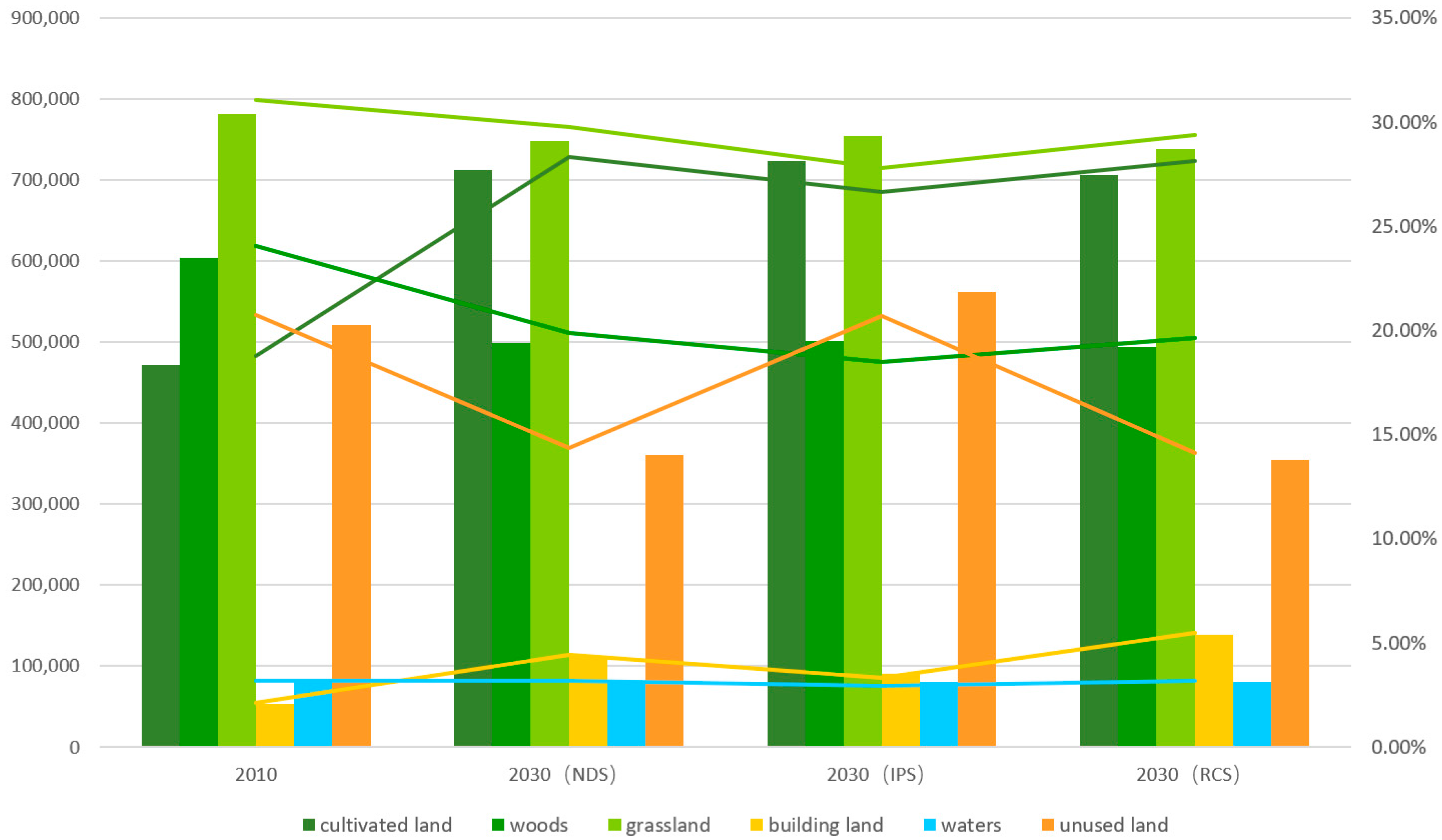Integrating IPAT and CLUMondo Models to Assess the Impact of Carbon Peak on Land Use
Abstract
1. Introduction
2. Materials and Methods
2.1. Study Area and Data Processing
2.2. Methods
2.2.1. Scenario Definitions
2.2.2. Carbon Emission Forecast
2.2.3. Land Use Change Prediction
3. Results
3.1. Carbon Emission Projections
3.2. Simulation Results of Land Use Change
3.3. Land Use Change under Different Scenarios
4. Discussion
4.1. Main Contributions
4.2. Study Limitations
5. Conclusions and Policy Recommendations
5.1. Conclusions
5.2. Policy Recommendations
Author Contributions
Funding
Institutional Review Board Statement
Informed Consent Statement
Data Availability Statement
Conflicts of Interest
References
- Gokhale, H. Japan’s carbon tax policy: Limitations and policy suggestions. Curr. Res. Environ. Sustain. 2021, 3, 100082. [Google Scholar] [CrossRef]
- Chepeliev, M.; Osorio-Rodarte, I.; van der Mensbrugghe, D. Distributional impacts of carbon pricing policies under the Paris Agreement: Inter and intra-regional perspectives. Energy Econ. 2021, 102, 105530. [Google Scholar] [CrossRef]
- Yu, P. Carbon tax/subsidy policy choice and its effects in the presence of interest groups. Energy Policy 2020, 147, 111886. [Google Scholar] [CrossRef]
- Zhang, S.; Wang, K.; Xu, W.; Iyer-Raniga, U.; Athienitis, A.; Ge, H.; Cho, D.W.; Feng, W.; Okumiya, M.; Yoon, G.; et al. Policy recommendations for the zero energy building promotion towards carbon neutral in Asia-Pacific Region. Energy Policy 2021, 159, 112661. [Google Scholar] [CrossRef]
- Zhang, W.-W.; Zhao, B.; Ding, D.; Sharp, B.; Gu, Y.; Xu, S.-C.; Xing, J.; Wang, S.-X.; Liou, K.-N.; Rao, L.-L. Co-benefits of subnationally differentiated carbon pricing policies in China: Alleviation of heavy PM2.5 pollution and improvement in environmental equity. Energy Policy 2021, 149, 112060. [Google Scholar] [CrossRef]
- Fu, Y.; He, C.; Luo, L. Does the low-carbon city policy make a difference? Empirical evidence of the pilot scheme in China with DEA and PSM-DID. Ecol. Indic. 2021, 122, 107238. [Google Scholar] [CrossRef]
- Chen, X.; Lin, B. Towards carbon neutrality by implementing carbon emissions trading scheme: Policy evaluation in China. Energy Policy 2021, 157, 112510. [Google Scholar] [CrossRef]
- Song, Q.; Liu, T.; Qi, Y. Policy innovation in low carbon pilot cities: Lessons learned from China. Urban Clim. 2021, 39, 100936. [Google Scholar] [CrossRef]
- Pan, X.; Pan, X.; Wu, X.; Jiang, L.; Guo, S.; Feng, X. Research on the heterogeneous impact of carbon emission reduction policy on R&D investment intensity: From the perspective of enterprise’s ownership structure. J. Clean. Prod. 2021, 328, 129532. [Google Scholar]
- Wei, S. A sequential game analysis on carbon tax policy choices in open economies: From the perspective of carbon emission responsibilities. J. Clean. Prod. 2021, 283, 124588. [Google Scholar] [CrossRef]
- Rustico, E.; Dimitrov, S. Environmental taxation: The impact of carbon tax policy commitment on technology choice and social welfare. Int. J. Prod. Econ. 2022, 243, 108328. [Google Scholar] [CrossRef]
- Liu, P.; Qiao, H. How does China’s decarbonization policy influence the value of carbon-intensive firms? Financ. Res. Lett. 2021, 43, 102141. [Google Scholar] [CrossRef]
- Kiss, T.; Popovics, S. Evaluation on the effectiveness of energy policies—Evidence from the carbon reductions in 25 countries. Renew. Sustain. Energy Rev. 2021, 149, 111348. [Google Scholar] [CrossRef]
- Zhao, P.; Deng, Q.; Zhou, J.; Han, W.; Gong, G.; Jiang, C. Optimal production decisions for remanufacturing end-of-life products under quality uncertainty and a carbon cap-and-trade policy. Comput. Ind. Eng. 2021, 162, 107646. [Google Scholar] [CrossRef]
- Shao, Z.; Xu, J.; Chung, C.K.L.; Spit, T.; Wu, Q. The State as Both Regulator and Player: The Politics of Transfer of Development Rights in China. Int. J. Urban Reg. Res. 2020, 44, 38–54. [Google Scholar] [CrossRef]
- Shi, H.; Chai, J.; Lu, Q.; Zheng, J.; Wang, S. The impact of China’s low-carbon transition on the economy, society, and energy in 2030 is based on CO2 emissions drivers. Energy 2022, 239, 122336. [Google Scholar] [CrossRef]
- Song, Y.; Chen, B.; Kwan, M.-P. How does urban expansion impact people’s exposure to green environments? A comparative study of 290 Chinese cities. J. Clean. Prod. 2020, 246, 119018. [Google Scholar] [CrossRef]
- Wu, H.; Fang, S.; Zhang, C.; Hu, S.; Nan, D.; Yang, Y. Exploring the impact of urban form on urban land use efficiency under low-carbon emission constraints: A case study in China’s Yellow River Basin. J. Environ. Manag. 2022, 311, 114866. [Google Scholar] [CrossRef]
- Yang, X.; Liu, X. Carbon conduction effect and temporal-spatial difference caused by land type transfer in Chang-Zhu-Tan urban agglomeration from 1995 to 2018. Acta Ecol. Sin. 2022. [Google Scholar] [CrossRef]
- Wang, H.; Lu, S.; Lu, B.; Nie, X. Overt and covert: The relationship between the transfer of land development rights and carbon emissions. Land Use Policy 2021, 108, 105665. [Google Scholar] [CrossRef]
- Tian, S.; Wang, S.; Bai, X.; Luo, G.; Li, Q.; Yang, Y.; Hu, Z.; Li, C.; Deng, Y. Global patterns and changes of carbon emissions from land use during 1992–2015. Environ. Sci. Ecotechnol. 2021, 7, 100108. [Google Scholar] [CrossRef]
- Chuai, X.; Gao, R.; Huang, X.; Lu, Q.; Zhao, R. The embodied flow of built-up land in China’s interregional trade and its implications for regional carbon balance. Ecol. Econ. 2021, 184, 106993. [Google Scholar] [CrossRef]
- Wu, S.; Hu, S.; Frazier, A.E. Spatiotemporal variation and driving factors of carbon emissions in three industrial land spaces in China from 1997 to 2016. Technol. Forecast. Soc. Chang. 2021, 169, 120837. [Google Scholar] [CrossRef]
- Huo, T.; Xu, L.; Feng, W.; Cai, W.; Liu, B. Dynamic scenario simulations of carbon emission peak in China’s city-scale urban residential building sector through 2050. Energy Policy 2021, 159, 112612. [Google Scholar] [CrossRef]
- Li, J.; Huang, X.; Chuai, X.; Yang, H. The impact of land urbanization on carbon dioxide emissions in the Yangtze River Delta, China: A multiscale perspective. Cities 2021, 116, 103275. [Google Scholar] [CrossRef]
- Zaman, K.; Moemen, M.A.-E. Energy consumption, carbon dioxide emissions and economic development: Evaluating alternative and plausible environmental hypothesis for sustainable growth. Renew. Sustain. Energy Rev. 2017, 74, 1119–1130. [Google Scholar] [CrossRef]
- Huang, Y.; Matsumoto, K. Drivers of the change in carbon dioxide emissions under the progress of urbanization in 30 provinces in China: A decomposition analysis. J. Clean. Prod. 2021, 322, 129000. [Google Scholar] [CrossRef]
- Wen, L.; Li, Z. Driving forces of national and regional CO2 emissions in China combined IPAT-E and PLS-SEM model. Sci. Total Environ. 2019, 690, 237–247. [Google Scholar] [CrossRef]
- Song, M.; Wang, S.; Yu, H.; Yang, L.; Wu, J. To reduce energy consumption and to maintain rapid economic growth: Analysis of the condition in China based on expended IPAT model. Renew. Sustain. Energy Rev. 2011, 15, 5129–5134. [Google Scholar] [CrossRef]
- Wang, C.; Wang, F.; Zhang, X.; Yang, Y.; Su, Y.; Ye, Y.; Zhang, H. Examining the driving factors of energy related carbon emissions using the extended STIRPAT model based on IPAT identity in Xinjiang. Renew. Sustain. Energy Rev. 2017, 67, 51–61. [Google Scholar] [CrossRef]
- Chontanawat, J. Decomposition analysis of CO2 emission in ASEAN: An extended IPAT model. Energy Procedia 2018, 153, 186–190. [Google Scholar] [CrossRef]
- York, R.; Rosa, E.A.; Dietz, T. STIRPAT, IPAT and ImPACT: Analytic tools for unpacking the driving forces of environmental impacts. Ecol. Econ. 2003, 46, 351–365. [Google Scholar] [CrossRef]
- Li, A.J.; Zhang, A.Z.; Zhou, Y.X.; Yao, X. Decomposition analysis of factors affecting carbon dioxide emissions across provinces in China. J. Clean. Prod. 2017, 141, 1428–1444. [Google Scholar] [CrossRef]
- Zhou, J.; Wang, Y.; Liu, X.; Shi, X.; Cai, C. Spatial-temporal differences of provincial carbon emissions and carbon compensation in China based on land use change. Geogr. Sci. 2019, 39, 1955–1961. (In Chinese) [Google Scholar]
- Bart, I.L. Urban sprawl and climate change: A statistical exploration of cause and effect, with policy options for the EU. Land Use Policy 2010, 27, 283–292. [Google Scholar] [CrossRef]
- Siikamäki, J.; Newbold, S.C. Potential Biodiversity Benefits from International Programs to Reduce Carbon Emissions from Deforestation. Ambio 2012, 41, 78–89. [Google Scholar] [CrossRef][Green Version]
- Ostle, N.; Levy, P.; Evans, C.; Smith, P. UK land use and soil carbon sequestration. Land Use Policy 2009, 26, S274–S283. [Google Scholar] [CrossRef]
- Hutyra, L.R.; Yoon, B.; Hepinstall-Cymerman, J.; Alberti, M. Carbon consequences of land cover change and expansion of urban lands: A case study in the Seattle metropolitan region. Landsc. Urban Plan. 2011, 103, 83–93. [Google Scholar] [CrossRef]
- Feng, Y.; Chen, S.; Tong, X.; Lei, Z.; Gao, C.; Wang, J. Modeling changes in China’s 2000–2030 carbon stock caused by land use change. J. Clean. Prod. 2020, 252, 119659. [Google Scholar] [CrossRef]
- Yang, X.; Zheng, X.-Q.; Lv, L.-N. A spatiotemporal model of land use change based on ant colony optimization, Markov chain and cellular automata. Ecol. Model. 2012, 233, 11–19. [Google Scholar] [CrossRef]
- Verburg, P.H.; de Koning, G.H.J.; Kok, K.; Veldkamp, A.T. A spatial explicit allocation procedure for modelling the pattern of land use change based upon actual land use. Ecol. Model. 1999, 116, 45–61. [Google Scholar] [CrossRef]
- Van Gossum, P.; Arts, B.; van Laar, J.; Verheyen, K. Implementation of the forest expansion policy in the Netherlands in the period 1986–2007: Decline in success? Land Use Policy 2010, 27, 1171–1180. [Google Scholar] [CrossRef]
- Jiang, W.; Deng, Y.; Tang, Z.; Lei, X.; Chen, Z. Modelling the potential impacts of urban ecosystem changes on carbon storage under different scenarios by linking the CLUE-S and the InVEST models. Ecol. Model. 2017, 345, 30–40. [Google Scholar] [CrossRef]
- Wilson, S.; Schuster, R.; Rodewald, A.; Bennett, J.; Smith, A.; La Sorte, F.; Verburg, P.; Arcese, P. Prioritize diversity or declining species? Trade-offs and synergies in spatial planning for the conservation of migratory birds in the face of land cover change. Biol. Conserv. 2019, 239, 108285. [Google Scholar] [CrossRef]
- Li, L.; Yang, J. A new method of energy-related carbon dioxide emissions estimation at the provincial-level: A case study of Shandong Province, China. Sci. Total Environ. 2020, 700, 134384. [Google Scholar] [CrossRef]
- Zhou, D.; Li, Z.; Wang, S.; Tian, Y.; Zhang, Y.; Jiang, G. How does the newly urban residential built-up density differ across Chinese cities under rapid urban expansion? Evidence from residential FAR and statistical data from 2007 to 2016. Land Use Policy 2021, 104, 105365. [Google Scholar] [CrossRef]
- Zhang, P.; Yang, D.; Qin, M.; Jing, W. Spatial heterogeneity analysis and driving forces exploring of built-up land development intensity in Chinese prefecture-level cities and implications for future Urban Land intensive use. Land Use Policy 2020, 99, 104958. [Google Scholar] [CrossRef]
- Li, G.; Wei, W. Financial development, openness, innovation, carbon emissions, and economic growth in China. Energy Econ. 2021, 97, 105194. [Google Scholar] [CrossRef]
- Fang, J.; Guo, Z.; Piao, S.; Chen, A. Terrestrial vegetation carbon sinks in China, 1981–2000. Sci. China Ser. D Earth Sci. 2007, 50, 1341–1350. [Google Scholar] [CrossRef]
- Van Asselen, S.; Verburg, P.H. Land cover change or land-use intensification: Simulating land system change with a global-scale land change model. Glob. Chang. Biol. 2013, 19, 3648–3667. [Google Scholar] [CrossRef]
- Jin, G.; Chen, K.; Wang, P.; Guo, B.; Dong, Y.; Yang, J. Trade-offs in land-use competition and sustainable land development in the North China Plain. Technol. Forecast. Soc. Chang. 2019, 141, 36–46. [Google Scholar] [CrossRef]
- Connor, J.D.; Bryan, B.A.; Nolan, M.; Stock, F.; Gao, L.; Dunstall, S.; Graham, P.; Ernst, A.; Newth, D.; Grundy, M.; et al. Modelling Australian land use competition and ecosystem services with food price feedbacks at high spatial resolution. Environ. Model. Softw. 2015, 69, 141–154. [Google Scholar] [CrossRef]
- Brabec, E.; Smith, C. Agricultural land fragmentation: The spatial effects of three land protection strategies in the eastern United States. Landsc. Urban Plan. 2002, 58, 255–268. [Google Scholar] [CrossRef]
- Wang, H.; Tao, R.; Tong, J. Trading land development rights under a planned land use system: The “Zhejiang Model”. China World Econ. 2009, 17, 66–82. [Google Scholar] [CrossRef]
- Linkous, E.R.; Chapin, T.S. TDR Program Performance in Florida. J. Am. Plan. Assoc. 2014, 80, 253–267. [Google Scholar] [CrossRef]
- Neeff, T.; Graça, P.M.D.A.; Dutra, L.V.; Freitas, C.D.C. Carbon budget estimation in Central Amazonia: Successional forest modeling from remote sensing data. Remote Sens. Environ. 2005, 94, 508–522. [Google Scholar] [CrossRef]
- Xu, Q.; Yang, R.; Dong, Y.-X.; Liu, Y.-X.; Qiu, L.-R. The influence of rapid urbanization and land use changes on terrestrial carbon sources/sinks in Guangzhou, China. Ecol. Indic. 2016, 70, 304–316. [Google Scholar] [CrossRef]
- Ali, G.; Pumijumnong, N.; Cui, S. Valuation and validation of carbon sources and sinks through land cover/use change analysis: The case of Bangkok metropolitan area. Land Use Policy 2018, 70, 471–478. [Google Scholar] [CrossRef]
- Geoghegan, J.; Lawrence, D.; Schneider, L.C.; Tully, K. Accounting for carbon stocks in models of land-use change: An application to Southern Yucatan. Reg. Environ. Chang. 2010, 10, 247–260. [Google Scholar] [CrossRef]
- Mannan, A.; Liu, J.; Zhongke, F.; Khan, T.U.; Saeed, S.; Mukete, B.; ChaoYong, S.; Yongxiang, F.; Ahmad, A.; Amir, M.; et al. Application of land-use/land cover changes in monitoring and projecting forest biomass carbon loss in Pakistan. Glob. Ecol. Conserv. 2019, 17, e00535. [Google Scholar] [CrossRef]
- Malek, Ž.; Verburg, P. Adaptation of land management in the Mediterranean under scenarios of irrigation water use and availability. Mitig. Adapt. Strat. Glob. Chang. 2018, 23, 821–837. [Google Scholar] [CrossRef] [PubMed]
- Dong, F.; Bian, Z.; Yu, B.; Wang, Y.; Zhang, S.; Li, J.; Su, B.; Long, R. Can land urbanization help to achieve CO2 intensity reduction target or hinder it? Evidence from China. Resour. Conserv. Recycl. 2018, 134, 206–215. [Google Scholar] [CrossRef]
- Nie, X.; Wu, J.; Chen, Z.; Zhang, A.; Wang, H. Can environmental regulation stimulate the regional Porter effect? Double test from quasi-experiment and dynamic panel data models. J. Clean Prod. 2021, 314, 128027. [Google Scholar] [CrossRef]
- Nie, X.; Wu, J.; Zhang, W.; Zhang, J.; Wang, W.; Wang, Y.; Luo, Y.; Wang, H. Can environmental regulation promote urban innovation in the underdeveloped coastal regions of western China? Mar. Pol. 2021, 133, 104709. [Google Scholar] [CrossRef]
- Nie, X.; Wu, J.; Wang, H.; Li, L.; Huang, C.; Li, W.; Wei, Z. Booster or Stumbling Block? The Role of Environmental Regulation in the Coupling Path of Regional Innovation under the Porter Hypothesis. Sustainability 2022, 14, 2876. [Google Scholar] [CrossRef]



| Land Use Types | Carbon Emission Coefficient (tC/ha) | Data Sources |
|---|---|---|
| Cultivated land | 0.0422 | Lai L (2010) |
| Woods (Forest land) | −0.0578 | Lai L (2010) |
| Grassland | −0.0021 | Fang et al. (2007) |
| Building (Construction) land | 4.2970 | Duan et al. (2008) |
| Water areas | −0.0252 | Fang et al. (2007) |
| Unused land | −0.0005 | Lai L (2010) |
| YEAR | NDS | IPS | RCS |
|---|---|---|---|
| 2020 | 1,225,638 | 1,185,640 | 1,225,638 |
| 2021 | 1,275,673 | 1,200,493 | 1,351,896 |
| 2022 | 1,284,722 | 1,213,784 | 1,442,836 |
| 2023 | 1,293,836 | 1,225,510 | 1,539,893 |
| 2024 | 1,303,014 | 1,235,673 | 1,643,479 |
| 2025 | 1,312,334 | 1,244,273 | 1,754,033 |
| 2026 | 1,321,643 | 1,251,309 | 1,872,024 |
| 2027 | 1,331,018 | 1,256,781 | 1,963,599 |
| 2028 | 1,340,460 | 1,260,690 | 1,977,528 |
| 2029 | 1,349,969 | 1,263,036 | 1,991,556 |
| 2030 | 1,364,076 | 1,263,818 | 2,005,684 |
| Land Use Type | NDS | IPS | RCS |
|---|---|---|---|
| Cultivated land | 711,981 | 723,599 | 706,976 |
| Woods (Forestland) | 499,288 | 501,317 | 493,552 |
| Grassland | 748,264 | 754,666 | 738,621 |
| Building (Construction) land | 112,055 | 91,036 | 138,363 |
| Water areas | 80,702 | 80,702 | 80,697 |
| Unused land | 361,087 | 562,057 | 355,178 |
Publisher’s Note: MDPI stays neutral with regard to jurisdictional claims in published maps and institutional affiliations. |
© 2022 by the authors. Licensee MDPI, Basel, Switzerland. This article is an open access article distributed under the terms and conditions of the Creative Commons Attribution (CC BY) license (https://creativecommons.org/licenses/by/4.0/).
Share and Cite
Wang, H.; Jin, Y.; Hong, X.; Tian, F.; Wu, J.; Nie, X. Integrating IPAT and CLUMondo Models to Assess the Impact of Carbon Peak on Land Use. Land 2022, 11, 573. https://doi.org/10.3390/land11040573
Wang H, Jin Y, Hong X, Tian F, Wu J, Nie X. Integrating IPAT and CLUMondo Models to Assess the Impact of Carbon Peak on Land Use. Land. 2022; 11(4):573. https://doi.org/10.3390/land11040573
Chicago/Turabian StyleWang, Han, Yujie Jin, Xingming Hong, Fuan Tian, Jianxian Wu, and Xin Nie. 2022. "Integrating IPAT and CLUMondo Models to Assess the Impact of Carbon Peak on Land Use" Land 11, no. 4: 573. https://doi.org/10.3390/land11040573
APA StyleWang, H., Jin, Y., Hong, X., Tian, F., Wu, J., & Nie, X. (2022). Integrating IPAT and CLUMondo Models to Assess the Impact of Carbon Peak on Land Use. Land, 11(4), 573. https://doi.org/10.3390/land11040573







